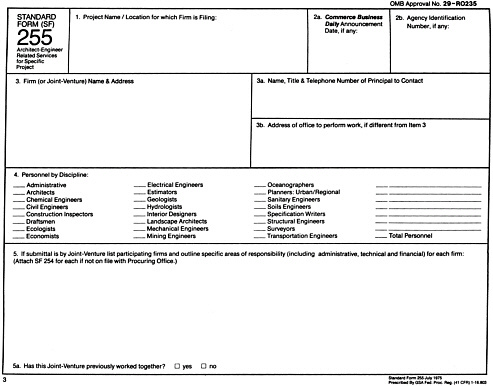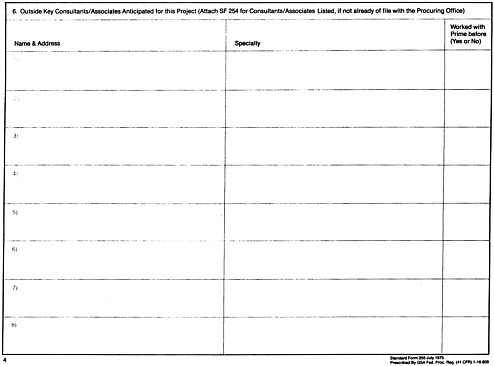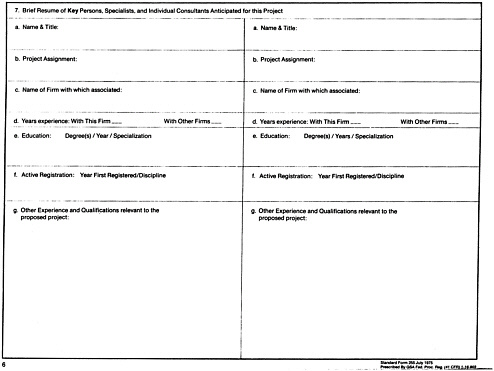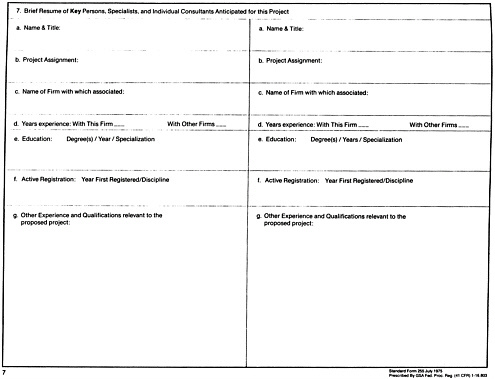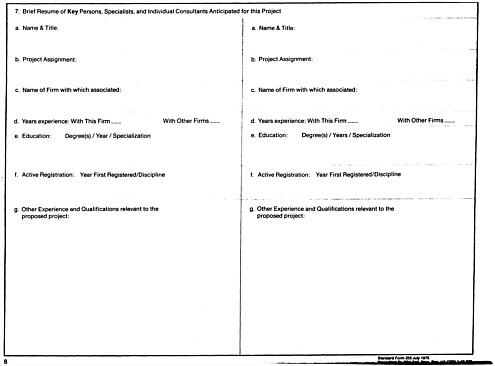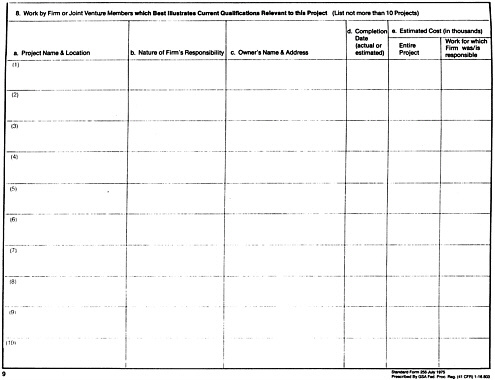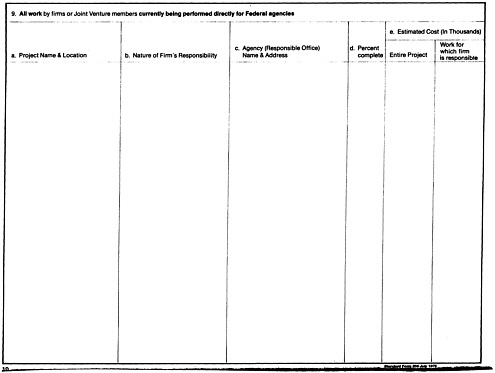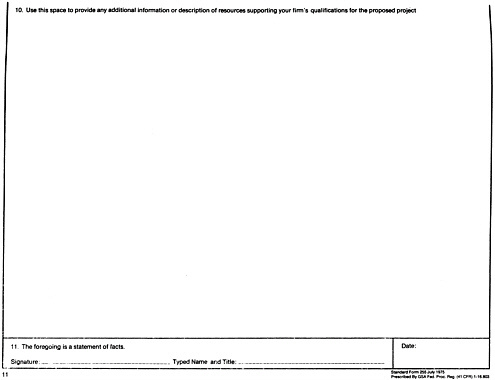STANDARD FORM (SF) 255
Architect-Engineer and Related Services Questionnaire for Specific Project
Standard Form 255
General Services Administration
Washington, D.C. 20405
Armed Svc. Proc. Reg. 18–403
Purpose:
This form is a supplement to the “Architect-Engineer and Related Services Questionnaire” (SF 254). Its purpose is to provide additional information regarding the qualifications of interested firms to undertake a specific Federal A-E project. Firms, or branch offices of firms, submitting this form should enclose (or already have on file with the appropriate office of the agency) a current (within the past year) and accurate copy of the SF 254 for that office.
The procurement official responsible for each proposed project may request submission of the SF 255 “Architect-Engineer and Related Services Questionnaire for Specific Project” in accord with applicable civilian and military procurement regulations and shall evaluate such submissions, as well as related information contained on the Standard Form 254, and any other performance data on file with the agency, and shall select firms for subsequent discussions leading to contract award in conformance with Public Law 92–582. This form should only be filed by an architect-engineer or related services firm when requested to do so by the agency or by a public announcement. Responses should be as complete and accurate as possible, contain data relative to the specific project for which you wish to be considered, and should be provided, by the required due date, to the office specified in the request or public announcement.
This form will be used only for the specified project. Do not refer to this submittal in response to other requests or public announcements.
Definitions:
“Architect-engineer and related services” are those professional services associated with research, development, design and construction, alteration, or repair of real property, as well as incidental services that members of these professions and those in their employ may logically or justifiably perform, including studies, investigations, surveys, evaluations, consultations, planning, programming, conceptual designs, plans and specifications, cost estimates, inspections, shop drawing reviews, sample recommendations, preparation of operating and maintenance manuals, and other related services.
“Principals” are those individuals in a firm who possess legal responsibility for its management. They may be owners, partners, corporate officers, associates, administrators, etc.
“Discipline”, as used in this questionnaire, refers to the primary technological capability of individuals in the responding firm. Possession of an academic degree, professional registration, certification, or extensive experience in a particular field of practice normally reflects an individual’s primary technical discipline.
“Joint Venture”, is a collaborative undertaking of two or more firms or individuals for which the participants are both jointly and individually responsible.
“Key Persons, Specialists, and Individual Consultants”, as used in this questionnaire, refer to individuals who will have major project responsibility or will provide unusual or unique capabilities for the project under consideration.
Instructions for Filing (Numbers below correspond to numbers contained in form):
-
Give name and location of the project for which this form is being submitted.
-
Provide appropriate data from the Commerce Business Daily (CBD) identifying the particular project for which this form is being filed.
2a. Give the date of the Commerce Business Daily in which the project announcement appeared, or indicate “not applicable” (N/A) if the source of the announcement is other than the CBD.
2b. Indicate Agency identification or contract number as provided in the CBD announcement.
-
Show name of the individual or firm (or joint venture) which is submitting this form for the project.
3a. List the name, title, and telephone number of that principal who will serve as the point of contact. Such an individual must be empowered to speak for the firm on policy and contractual matters and should be familiar with the programs and procedures of the agency to which this form is directed.
3b. Give the address of the specific office which will have responsibility for performing the announced work.
-
Insert the number of personnel by discipline presently employed (on date of this form) at work location. While some personnel may be qualified in several disciplines, each person should be counted only once in accord with his or her primary function. Include clerical personnel as “administrative.” Write in any additional disciplines—sociologists, biologists, etc. —and number of people in each, in blank spaces.
-
Answer only if this form is being submitted by a joint venture of two or more collaborating firms. Show the names and addresses of all individuals or organizations expected to be included as part of the joint venture and describe their particular areas of anticipated responsibility, (i.e., technical disciplines, administration, financial, sociological, environmental, etc.)
5a. Indicate, by checking the appropriate box, whether this particular joint venture has successfully worked together on other projects.
Each firm participating in the joint venture should have a Standard Form 254 on file with the contracting office receiving this form. Firms which do not have such forms on file should provide same immediately along with a notation
-
regarding their association with this joint venture submittal.
-
If respondent is not a joint venture, but intends to use outside (as opposed to in-house or permanently and formally affiliated) consultants or associates, he should provide names and addresses of all such individuals or firms, as well as their particular areas of technical/professional expertise, as it relates to this project. Existence of previous working relationships should be noted. If more than eight outside consultants or associates are anticipated, attach an additional sheet containing requested information.
-
Regardless of whether respondent is a joint venture or an independent firm, provide brief resumes of key personnel expected to participate on this project. Care should be taken to limit resumes to only those personnel and specialists who will have major project responsibilities. Each resume must include: (a) name of each key person and specialist and his or her title, (b) the project assignment or role which that person will be expected to fulfill in connection with this project, (c) the name of the firm or organization, if any, with whom that individual is presently associated, (d) years of relevant experience with present firm and other firms, (e) the highest academic degree achieved and the discipline covered (if more than one highest degree, such as two Ph.D.’s, list both), the year received and the particular technical/professional discipline which that individual will bring to the project, (f) if registered as an architect, engineer, surveyor, etc., show only the field of registration and the year that such registration was first acquired. If registered in several states, do not list states, and (g) a synopsis of experience, training, or other qualities which reflect individual’s potential contribution to this project. Include such data as: familiarity with Government or agency procedures, similar type of work performed in the past, management abilities, familiarity with the geographic area, relevant foreign language capabilities, etc. Please limit synopsis of experience to directly relevant information.
-
List up to ten projects which demonstrate the firm’s or joint venture’s competence to perform work similar to that likely to be required on this project. The more recent such projects, the better. Prime consideration will be given to projects which illustrate respondent’s capability for performing work similar to that being sought. Required information must include: (a) name and location of project, (b) brief description of type and extent of services provided for each project (submissions by joint ventures should indicate which member of the joint venture was the prime on that particular project and what role it played), (c) name and address of the owner of that project (if Government agency, indicate responsible office), (d) completion date (actual or estimated), (e) total construction cost of completed project, (or where no construction was involved, the approximate cost of your work) and that portion of the cost of the project for which the named firm was/is responsible.
-
List only those projects which the A-E firm or joint venture, or members of the joint venture, are currently performing under direct contract with an agency or department of the Federal Government. Exclude any grant or loan projects being financed by the Federal Government but being performed under contract to other non Federal governmental entities. Information provided under each heading is similar to that requested in the preceding Item 8, except for (d) “Percent Complete.” Indicate in this item the percentage of A-E work completed upon filing this form.
-
Through narrative discussion, show reason why the firm or joint venture submitting this questionnaire believes it is especially qualified to undertake the project. Information provided should include, but not be limited to, such data as: specialized equipment available for this work, any awards or recognition received by a firm or individuals for similar work, required security clearances, special approaches or concepts developed by the firm relevant to this project, etc. Respondents may say anything they wish in support of their qualifications. When appropriate, respondents may supplement this proposal with graphic material and photographs which best demonstrate design capabilities of the team proposed for this project.
-
Completed forms should be signed by the chief executive officer of the joint venture (thereby attesting to the concurrence and commitment of all members of the joint venture), or by the architect-engineer principal responsible for the conduct of the work in the event it is awarded to the organization submitting this form. Joint ventures selected for subsequent discussions regarding this project must make available a statement of participation signed by a principal of each member of the joint venture. ALL INFORMATION CONTAINED IN THE FORM SHOULD BE CURRENT AND FACTUAL.

